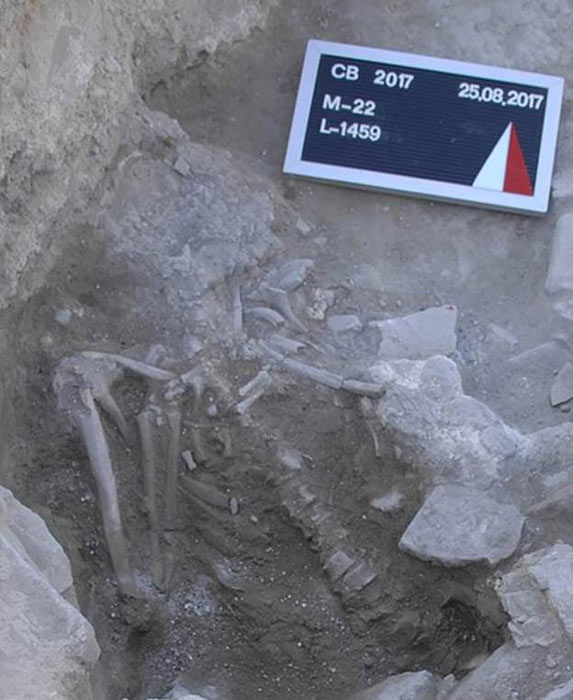Archaeologists have recovered the shattered skeletons of a man and a dog at a site in Turkey. Their frames were both smashed to pieces, but not by an act of human violence, but by the force of a huge tsunami tidal wave that was sparked by the mega-volcano Thera eruption.
The human and dog skeletal remains found at the Çeşme-Bağlararası archaeological site, near Çeşme Bay, on Turkey’s western coastline, were created when the Thera mega-volcano (modern-day Santorini) erupted in the late Bronze Age. The Thera eruption blast of roughly 1600 BC happened 249 miles (400 kilometers) distant from the articulated human skeleton and a dog skeleton recently uncovered in Turkey. This tells us that the destructive tsunami tidal wave caused by the Thera eruption travelled a great distance with deathly consequences for countless peoples. The Santorini Thera eruption, now a caldera at the center of the Greek island, is thought to have ended the magnificent Minoan civilization based on nearby Crete.
Now, tsunami deposits discovered at the Turkish Çeşme-Bağlararası site have revealed how multiple massive destructive waves smashed across the northern Aegean after the Thera eruption. And this has all become evident from the way the skeletons of the man and the dog had been broken to pieces.

The remains of a young man unearthed in Turkey near the skeleton of a dog, both were victims of the mega tsunami tidal waves caused by the Santorini Thera eruption or Minoan eruption. ( PNAS)
The Thera Eruption: A Historic Volcanic Blast To Rival Most
The history of the eastern Mediterranean features many glorious battles, heroic deeds, and the rise and fall of numerous great civilizations. However, sometimes, nature was the biggest predictor of political and military outcomes. The tsunami tidal waves generated by the Thera eruption practically wiped out the Minoan civilization on the island of Crete. Akrotiri, a Minoan city buried in ash by Thera, is a popular tourist attraction often likened to Pompeii. But now, based on the latest study published in the Proceedings of the National Academy of Sciences (PNAS), the full extent of the Tera tsunami’s impact is become much clearer.
According to National Geographic the “super-colossal” eruption of Thera was like the detonation of several million Hiroshima nuclear bombs. So brutal was the event that the social trauma may have inspired Plato’s tales of the sunken city of Atlantis.
Archaeologist Vasıf Şahoğlu of the University of Ankara has published a full analysis of the new discoveries of the man and dog skeletons in PNAS. The study says the Late Bronze Age Thera eruption was one of the “largest natural disasters witnessed in human history.” Radiocarbon dating of tsunami deposits gathered at Çeşme-Bağlararası suggest the volcano erupted no earlier than 1612 BC.

The tsunami tidal wave caused by the Thera eruption travelled more than 250 miles or 400 kilometers to the northern Turkish coastline on the Aegean Sea the latest PNAS study revealed. ( willyam / Adobe Stock)
Digging Up Thera’s Rare Bone-rich Post-tsunami Layers
In reference to the Thera eruption, the PNAS study’s lead archaeologist said that the impact, consequences, and timing of the tsunami have “dominated the discourse of ancient Mediterranean studies for nearly a century.” However, while many pumice, ash, and tephra deposits have been analyzed, only a few tsunami deposits have ever been found. This is why the discovery of the ancient Turkish man and dog skeletons are so important for scientifically understanding the Thera eruption event.
A series of damaged walls at the Çeşme-Bağlararası site indicated that the settlement had been fortified. The shattered walls were found to be lined with “chaotic sediments characteristic of tsunami deposits” according to the study. The upper two layers were volcanic ash , but the so-called “bone-rich layer,” containing charcoal and other charred remains, was found at a depth of roughly 7 feet (2 meters). These layers, according to the scientists, represent “at least four consecutive tsunami inundations” resulting from the Thera eruption .
The young man’s skeleton had been swept along by tsunami debris flow and had been crushed against the most badly damaged portion of the fortification wall. Archaeologists discovered the body about 3.3 feet (one meter) below a pit.
Other misshapen, crudely dug pits, were discovered at various places across the Çeşme-Bağlararası site. The researchers believe these were efforts to uncover victims from the tsunami debris in the immediate aftermath of the disaster. The man’s skeleton suggests he was in too deep and that the survivors left him there to perish.
Top image: A recent PNAS study has revealed the extent of the Tera eruption’s tsunami wave destruction across the northern Aegean based on Late Bronze Age skeletons found in northern Turkey. Source: MiaStendal / Adobe Stock
By Ashley Cowie
 RSS Feed
RSS Feed















 December 30th, 2021
December 30th, 2021  Awake Goy
Awake Goy  Posted in
Posted in  Tags:
Tags: 













